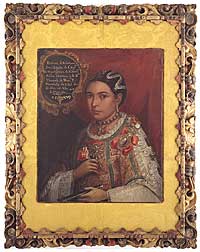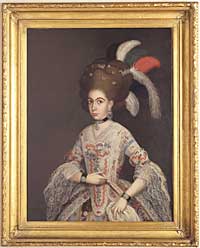
In this lesson students apply the criteria generated and used in the previous two lessons to understand and analyze two portraits from the Franz Mayer Exhibition. This exhibition showcases the culture and art of Viceregal Mexico. The Viceregal period (1521-1821) was the 300 year colonial period, when Mexico was governed by viceroys appointed by King of Spain. The control of much of the land ended up in the hands of the church and the politically powerful.
Assuming the role of portrait detectives, students research items in the portraits in small groups and report on their findings.
1. What criteria did we develop?
The teacher begins this lesson by reviewing the questions in the previously developed criteria.
2. How does this criteria apply to two portraits of women in the Franz Mayer exhibit?
The teacher shows the two portraits below either from prints or from the links below, and asks the students to work in small groups or individually to answer the questions in the criteria.
3. How can you describe the culture and history surrounding these portraits?
Students can share the answers about these portraits in a variety of ways.
Presentations: Students can present their summary to the entire class or to each other in small groups.
Writing: Students can provide their answers in a short writing assignment. Depending on the age of the students and their writing abilities, the assignment might be as simple as one that summarizes what the portrait reveals or as complex as writing a short story or poem about the subject of the portrait.
Communications: Students can write a headline and a caption for the portrait as if it is in a newspaper. These headlines can be placed under the picture if displayed on a bulletin board.
Drama: Students can take the role of the subject of the portrait and perform a short skit as that character.
The two portraits used in this lesson are:

